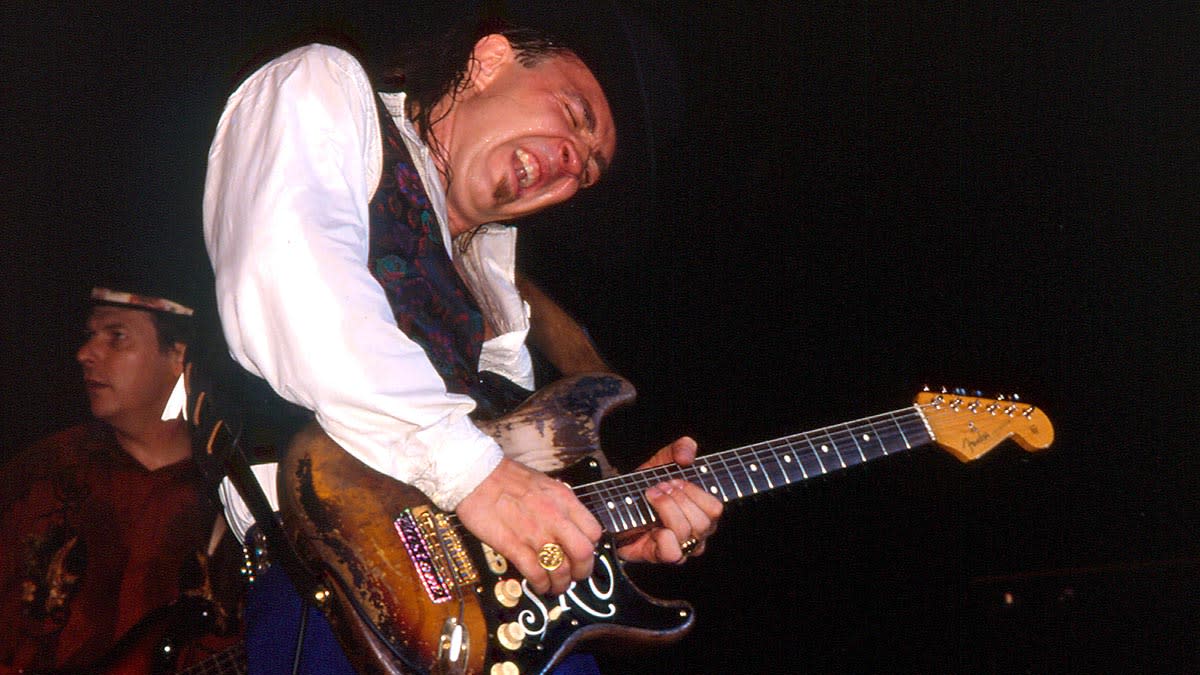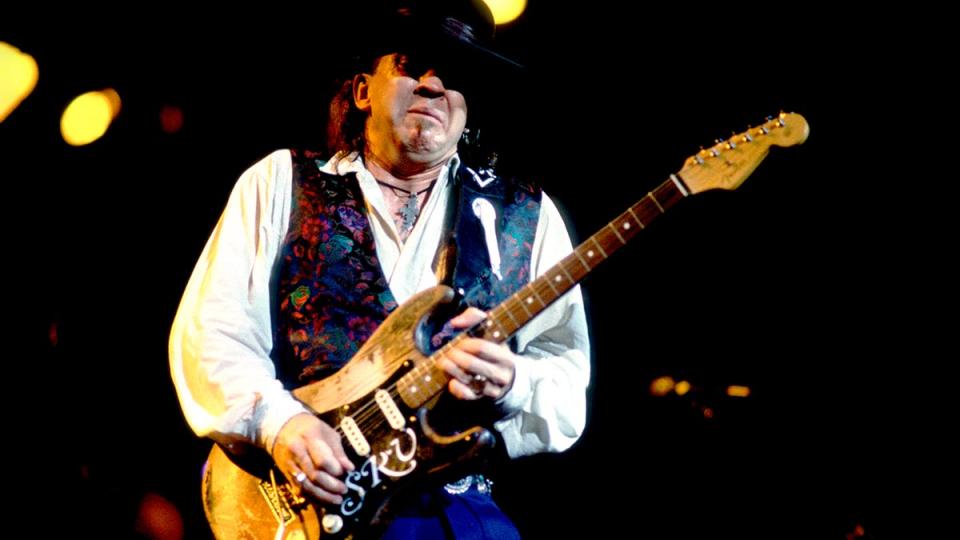His playing took Eric Clapton’s breath away and David Bowie called him the most exciting guitarist since Jeff Beck: how Stevie Ray Vaughan became a blues guitar hero

- Oops!Something went wrong.Please try again later.
- Oops!Something went wrong.Please try again later.
- Oops!Something went wrong.Please try again later.
- Oops!Something went wrong.Please try again later.
- Oops!Something went wrong.Please try again later.
- Oops!Something went wrong.Please try again later.
- Oops!Something went wrong.Please try again later.
When the legendary Jeff Beck passed away in January, he was remembered as a player who epitomised ‘feel’ in just about every conceivable way. Summarising the profound sense of loss for the guitar community, Total Guitar noted how Beck was truly in a class of his own. The same is true of another player we lost more than 30 years ago: Stevie Ray Vaughan.
SRV had that same magic touch that all guitarists strive for, never running out of ideas that could amaze the listener at every turn. As with Beck, you got the sense that this was a musician speaking through their instrument, conveying deep emotions and telling stories via the means with which they were most at ease – a rare gift in being able to effortlessly move audiences through honesty, passion and charisma.
Many guitar players will remember hearing the song Lenny for the first time and feeling like their eyes had just been opened – Stevie Ray Vaughan using sophisticated sixth voicings, Hendrixian doublestops and mouth-watering pentatonics to pay tribute to his wife Lenora Bailey, who bought him the 1965 Stratocaster also named after her.
Then there are tracks like Scuttle Buttin’ which saw him defining what would become known as the Texan sound, ripping through open position blues runs at speeds few had ever dared.
From early fan favourites like Pride and Joy, Texas Flood and Cold Shot to latter works like Crossfire, Tightrope and the jazz-influenced masterpiece Riviera Paradise, SRV was in many ways the Jimi Hendrix of the 1980s, paying tribute through renditions of Hendrix classics Voodoo Child (Slight Return) and Little Wing, and also by tuning half a step down.
“I loved Jimi a lot,” Stevie told Guitar World in 1984, noting how Hendrix “could do anything” and “was so much more than just a blues guitarist”, while also adding how he’d been learning various parts and “trying to expand on it – not that I can expand on it a whole bunch – but I try”.
Like his biggest hero and influence, SRV was a daredevil who would throw himself into the eye of the storm in order to conjure up magic, taking risks as an improviser and somehow managing to never set a foot wrong or run out of gas.
Comparisons can also be made to the late great Eddie Van Halen, and the sheer sense of technicality that they both brought to their respective genres – SRV taking the innovations of Albert King, B.B. King and Freddie King to new virtuosic heights, more aggressive than any blues artist before him and leading the charge for a whole new wave of harder-hitting players.
His range of dynamics was as wide as it gets, going from furious tremolo picking and wailing bends to breath-taking moments that were as quiet as a whisper, making the listener lean in and almost strain to hear the ghost notes he may or may not have been playing.
As Eric Clapton once said of SRV: “I don’t think anyone has commanded my respect more.” On that fateful night in 1990 when Stevie died in a helicopter crash, he and Clapton had performed together on stage mere hours earlier.
In a heartfelt tribute, Clapton recalled: “The first time I heard Stevie Ray, I thought, ‘Whoever this is, he is going to shake the world.’ I was in my car and I remember thinking, I have to find out, before the day is over, who that guitar player is. That doesn’t happen to me very often.
“I remember being fascinated by the fact that he never, ever seemed to be lost in any way… It was as though he never took a breather or took a pause to think where he was gonna go next, it just flowed out of him. It’s going to be a long time before anyone that brilliant will come along again.”
The first time I heard Stevie Ray, I thought, ‘Whoever this is, he is going to shake the world’
But it wasn’t just SRV’s playing that took the world by storm – it was also his tone, a glassy edge-of-breakup kind of sound that almost every blues player on earth will have ended up chasing at some point in their life.
And, all in all, his was a fairly simple rig: positions four and five on his Strats were often his favourites, usually fed through an Ibanez Tube Screamer (he used TS808s, TS9s and TS10s at various points of his career), along with a Vox V846 wah pedal that once belonged to Jimi Hendrix and a couple of high-powered Fender amps.
And let’s not forget the man’s dress sense – given his love for black hats, flamboyant shirts, cowboy boots, conchos and ponchos, he was someone who looked every bit the guitar legend.
He was born Stephen Ray Vaughan on October 3 1954 in Dallas, Texas, and as a young boy he was guided towards music by his older brother Jimmie, who went on to become famous in his own right as guitarist of The Fabulous Thunderbirds.
For his seventh birthday, Stevie was given a toy guitar from Sears, and a couple of years later he was donated a Gibson ES-125T from his brother, which he’d use to mimic the immortal lines he’d heard played by Albert King and Muddy Waters.
“Jimmie would leave his guitars around the house and tell me not to touch ’em,” Stevie once revealed. “And that’s basically how I got started. I actually wanted to be a drummer, but I didn’t have any drums. So I just go into what was available to me at the time.”
Through his early teens he performed with a number of bands – The Chantones, The Brooklyn Underground, Southern Distributor and Liberation, the latter supporting ZZ Top at Dallas’ Adolphus Hotel and even jamming on stage with them.
By this point, Stevie had lost interest at school and had ultimately decided what he was going to do with the rest of his life. He joined Cast Of Thousands, with whom he made his very first studio recordings, and then formed his own group, Blackbird, followed by stints in Krackerjack and then The Nightcrawlers.

But it was The Cobras that helped him cast his name as a Texan blues legend, and it was during these years that he wound up guesting with heroes like Buddy Guy, Hubert Sumlin, Lightnin’ Hopkins and Albert King at famous Austin blues nightclub Antone’s. After some personnel changes the band was renamed Double Trouble, eventually settling with Chris Layton on drums and Tommy Shannon as the bass player.
In 1982 the trio got their big break after being invited to perform at the prestigious Montreux Jazz Festival in Switzerland, but the set wasn’t particularly well received thanks to the amount of sheer volume coming from the stage.
As Stevie would recall of the booing they received, “It wasn’t the whole crowd. It was just a few people sitting right up front. The room there was built for acoustic jazz. When five or six people boo, wow, it sounds like the whole world hates you! They thought we were too loud, but shoot, I had four army blankets folded over my amp, and the volume level was on two. I’m used to playin’ on 10!”
Some good came out of it, however. One of the people watching happened to be one of the most famous musicians in the world, David Bowie, who later said of SRV’s playing: “It completely floored me.” Bowie was reminded of witnessing Jeff Beck play live in the ’60s in one of his early groups. “I hadn’t been so gung-ho about a guitar player since seeing Jeff Beck with The Tridents,” he raved.
And that wasn’t the only music contact that the band acquired during their first overseas visit. The night after the festival, the trio performed at Montreux Casino where singer-songwriter Jackson Browne was in attendance.
Browne was so impressed he offered them free use of his Los Angeles recording studio, and it was during these sessions, for what would become debut album Texas Flood, that Bowie called to invite Stevie to play on his album Let’s Dance – produced by legendary Chic guitarist Nile Rodgers.
SRV played lead on six of the eight tracks on Let’s Dance, a major contribution comparable to those of other great guitarist who had worked with Bowie in the past, including Mick Ronson, Robert Fripp and Carlos Alomar.
The album’s title track and lead single was more of a funk-pop number than the 12-bar turnarounds SRV had cut his teeth playing, which is perhaps what made his contributions so striking – taking the influence of blues to new places and winning himself new fans in the process, while also landing a deal with Epic for his solo releases.
The collaboration with Bowie came to an abrupt end, however. After he had been picked to play in Bowie’s backing group for a world tour on which he and Double Trouble were lined up as the opening act on selected dates, the offer was retracted, leaving Stevie with no choice but to throw himself into his own music. So that’s precisely what he did.
Texas Flood signalled the arrival of a new kind of blues that was less loose and free, and instead more focused, sharp and energetic. The album’s opening track Love Struck Baby sounded like Johnny B. Goode on steroids, while Pride and Joy and Testify had an irresistible swing to them thanks to SRV’s right hand strum.
Elsewhere, a stylish cover of Buddy Guy’s Mary Had A Little Lamb demonstrated a mid-tempo slickness to show how Stevie was much more than a one-trick pony, with the beautiful Lenny ended the album on an apex of vast emotional intelligence, pulling at the heartstrings like few guitarists had done before him. Stevie Ray Vaughan had arrived. Guitar music was never to be the same again…

